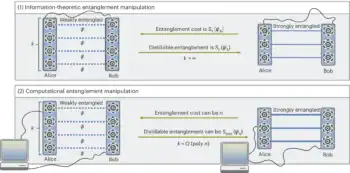
Bell correlations – a hallmark of an entangled quantum system – have been spotted in an ensemble of 500,000 rubidium-87 atoms. The atoms were prepared in spin-squeezed states by physicists at Stanford University in the US and the correlations measured to a whopping statistical significance of 124σ.
In quantum mechanics, entangled particles have much stronger correlations than are allowed in classical physics – a property that can be exploited in quantum technologies including cryptography. In 1964 the physicist John Bell famously calculated an upper limit on how strong these correlations could be if they were caused by classical physics alone – what has become known as Bell’s inequality. Correlations stronger than this limit, Bell reasoned, could occur only if the particles are entangled.
In this latest work, Onur Hosten, Mark Kasevich and colleagues have measured these strong Bell correlations in an ensemble of 500,000 cold rubidium-87 atoms that are trapped by laser light. The atoms are put into an entangled state using a process called spin squeezing. The uncertainty principle dictates that the uncertainty in a measurement of the z-component of the total spin of the system multiplied by the uncertainty in the y-component must be larger than a certain value. Reducing (or squeezing) the uncertainty of the z-component increases the uncertainty of y-component, putting the system into a spin-squeezed state.
Not a fluke
It turns out that the technique used by Hosten and colleagues to create a spin-squeezed state in their atomic system also puts the atoms into an entangled state. The team then characterized this state by measuring two quantities. One is related to the total spin of the atoms in the z direction and the other is related to the total spin of the atoms in a direction n, which is in the z–x plane. Correlations between these two quantities can be expressed in terms of a Bell-like inequality. The team found that for certain values of n, the inequality was violated – showing that entanglement is present in the system. For some values of n, the statistical significance of the violation was 124σ, making it extremely unlikely that the measurement was a random fluke.
Kai Bongs of the University of Birmingham in the UK describes the work as “a very nice experiment done on a fantastic system”, and points out that the Stanford team has taken the atomic ensemble “deep into the quantum domain”. However, Bongs, who works in the field of quantum sensors, says that practical applications of the Bell correlation measurements are not obvious. Hosten concurs: “We do not know any immediate practical applications of the Bell correlation measurements. However the spin-squeezed states have immediate applications in improving the precision of atomic clocks and atom interferometers.”
Hosten points out that the team’s study differs from conventional Bell experiments because it does not look at correlations between measurements made at two different places. If the system could be adapted for atom interferometry – whereby the atoms can follow two different paths – it could be used to further test the predictions of quantum theory. The measurements are described in Physical Review Letters.



